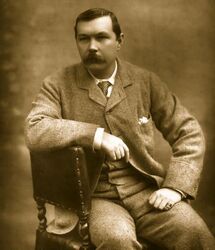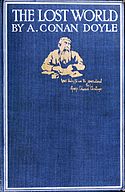
1890 photograph of Sir Arthur Conan Doyle.
Sir Arthur Ignatius Conan Doyle (May 22, 1859 - July 7, 1930) was a Scottish author who is best known for his Sherlock Holmes series. Doyle was a practicing physician for a time, writing and publishing in his spare time. As his literary output grew and the medical practice stagnated, he made the decision to abandon medicine altogether and write full-time. A prolific writer, Doyle wrote science fiction, romances, historical fiction, plays, poetry, and non-fiction in addition to the famous mystery series. In his later years, he became an ardent advocate of Spiritualism, lecturing and writing extensively on the subject.
Biography
Arthur Ignatius Conan Doyle was born in Edinburgh, Scotland in 1859 to Charles Altamont Doyle and Mary née Foley, both of Irish descent. He was the eldest son and the second of nine children. The family was poor, Charles having lost his job and become an alcoholic, so Arthur was initially educated by his mother at home. When he was nine, some of the wealthy Doyle family members offered financial assistance and Arthur was sent to a Jesuit boarding school in England.
In 1876, Doyle enrolled at the University of Edinburgh to study medicine. It was there that he met and became assistant to Dr. Joseph Bell. Dr. Bell had the remarkable power of observation which allowed him to quickly diagnose a medical condition and also to deduce occupation and other details about a patient. He would later inspire the character of the great detective Sherlock Holmes.
After obtaining his degree in 1881, Doyle briefly served as the medical officer on a steamer then opened a joint practice with a schoolmate in Plymouth. The partnership ended badly, and Doyle left for Southsea to open his own private practice. Although it struggled early on, the practice grew to earn Doyle a comfortable living in a few years. When one of his patients, Jack Hawkins, passed away, Doyle began helping his mother and sister Louisa. In August 1885, he married the gentle and sweet Louisa with whom he would have two children.

Front cover of an 1887 edition of Beeton's Christmas Annual in which A Study in Scarlet first appeared.

2006 image by Phil Cornell, based on an illustration for the Sherlock Holmes story "Silver Blaze", which shows illustrator Sidney Paget (as Holmes, on the left) and Sir Arthur Conan Doyle (as Watson, on the right).
Doyle had inherited the love of literature and the talent for storytelling from his mother. He wrote his first short story "The Mystery of Sasassa Valley" while still a student. It was published anonymously in an 1879 issue of Chamber's Journal in Edinburgh. He continued to write and publish while pursuing his medical career. In the spring of 1886, Doyle completed a mystery novel A Study in Scarlet featuring Sherlock Holmes and his friend Dr. John Watson. After several rejections, it was finally accepted and published in the 1887 issue of Beeton's Christmas Annual. In 1890, commissioned by Lippincott’s Magazine of Philadelphia, he wrote The Sign of the Four which introduced Holmes to America.
At the end of 1890, Doyle traveled to Europe to explore new medical treatments, closing his practice in Southsea. When he returned to England in 1891 and opened a new practice in London, he found few patients and finally made the decision to abandon medicine in favor of a literary career. In the spring of 1891, Doyle submitted two Sherlock Holmes stories to the Strand Magazine, a popular new periodical publishing short stories instead of serializations common at the time. The stories were accepted with enthusiasm, and "A Scandal in Bohemia" was published in the July issue followed by "The Red-Headed League" in August. The series was an immediate success and, after the first set of twelve tales, Doyle was paid handsomely for another twelve stories. The second series came to an end when, in December 1893, Doyle killed off the famous detective in "The Final Problem." He had considered ending the series as early as late 1891, concerned that the "commercial" stories prevented him from being recognized for his "serious" works, such as the historical novel Micah Clarke (1889) of which he was more proud. Doyle spent the following years writing "serious" novels, giving lectures, and caring for Louisa who was diagnosed with tuberculosis (which was a fatal disease at the time).
During the Boer War, Doyle supervised a hospital in Cape Town. He wrote and published a detailed account of the war in a volume entitled The Great Boer War (1900). He also wrote The War in South Africa: Its Cause and Conduct (1902) defending British actions during the war, which lead to his knighthood in 1902. After the war, he returned to Edinburgh and ran for a seat in Parliament. After losing the election, he moved back to London and began working on his next novel which was set in Dartmoor and based on folklore. The story needed a strong protagonist, and Doyle turned (for mostly financial reasons) to Sherlock Holmes. The Hound of the Baskervilles was published in the Strand Magazine beginning in August 1901 and became a worldwide sensation. The novel, written as a reminiscence, did not resurrect the great detective. Two years later, however, Doyle finally gave in and brought Holmes back to life in a new series of short stories.
When Louisa died in July 1906, Doyle slipped into depression. After months of inactivity, he shook off his depression when his attention was caught by the case of George Edalji who had been imprisoned for animal mutilation on questionable evidence. Doyle investigated and wrote about the case, and helped prove Edalji's innocence and secure his pardon in 1907. Doyle would go on to investigate other cases involving miscarriages of justice.

June 1914 photograph of Sir Arthur Conan Doyle.
In September 1907, Doyle married Jean Leckie, the beautiful daughter of a family friend. After the marriage, which gave him three more children, Doyle's literary output slowed down considerably. He wrote some plays but did not have any success until he again turned to Sherlock Holmes. The Speckled Band opened in 1910 to rave reviews, had a good run, and allowed Doyle to recover from financial losses suffered earlier. Abandoning the theater, Doyle then made his successful return to fiction in 1912 with The Lost World, an adventure story featuring Professor Challenger, followed quickly by a sequel The Poison Belt (1913). In 1914, the last of the Holmes novels The Valley of Fear was serialized in the Strand Magazine.
When World War I began, Doyle organized a civilian volunteer corps. He also began writing The British Campaign in France and Flanders, a six-volume history which would be completed and published in 1920. After the war, Doyle, who had long been interested in psychic phenomena, devoted himself to promoting Spiritualism. He toured around the world giving lectures and also concentrated his literary efforts on the subject, only writing Professor Challenger and Sherlock Holmes stories to finance his activities. After an arduous tour, Doyle returned to England exhausted and in ill health. He died at home from a heart attack on July 7, 1930.
Selected works

Sir Arthur Conan Doyle's signature.

Front cover of a first edition of The Lost World from 1912.

Front cover of a first edition of The Hound of the Baskervilles from 1902.
Professor Challenger novels and short stories
- The Lost World (1912)
- The Poison Belt (1913)
- The Land of Mist (1926)
- "When The World Screamed" (1928)
- "The Disintegration Machine" (1929)
Sherlock Holmes novels and short story collections
- A Study in Scarlet (1887)
- The Sign of the Four (1890)
- The Hound of the Baskervilles (1902)
- The Valley of Fear (1915)
- The Adventures of Sherlock Holmes (1892)
- The Memoirs of Sherlock Holmes (1893)
- The Return of Sherlock Holmes (1905)
- His Last Bow: Some Reminiscences of Sherlock Holmes (1917)
- The Casebook of Sherlock Holmes (1927)
Other works
- Micah Clarke (historical novel, 1889)
- The Exploits of Brigadier Gerard (short story collection, 1896)
- The Great Boer War (non-fiction, 1900)
- Sir Nigel (historical novel, 1906)
- The Wanderings of a Spiritualist (memoir, 1921)
- Memories and Adventures (autobiography, 1924)
